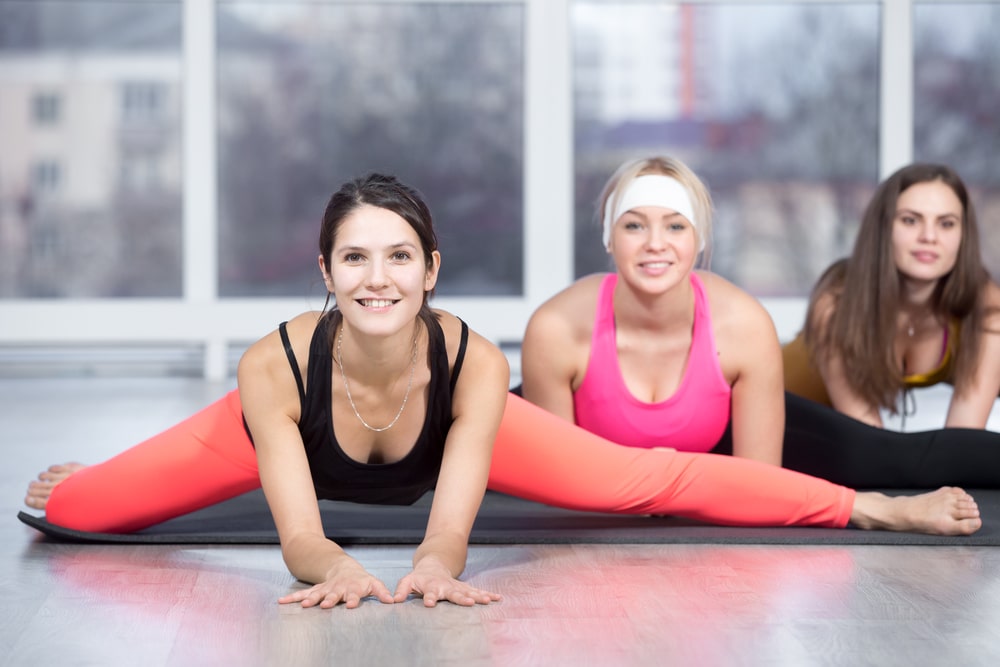What is hot yoga exactly? Hot Yoga is a form of Hatha yoga (yoga as exercise) performed at a high temperature—usually 80-105⁰F. In the world of hot yoga today, you can typically find two types: Bikram yoga and general hot yoga, which is any yoga that is performed in a heated room.
Hot yoga rose to popularity in the 1970s when Bikram Choudhury created Bikram yoga. This is easily the most famous type of hot yoga due to its popularity among Hollywood stars. Since its rise to fame, many celebrities, such as Jennifer Aniston, Jessica Alba and even Duchess Meghan Markle have taken up hot yoga practice.
Bikram yoga is a specific kind of hot yoga that incorporates a set of 26 yoga poses, 24 asanas and two breathing exercises. It is characterized by extreme heat compared to other types of hot yoga; the rooms are kept at 105⁰F and 40% humidity to emulate the climate of India Bikram yoga classes are very strict: no music, talking or clapping is allowed.
Otherwise, hot yoga can refer to any kind of yoga performed at a high temperature and humidity. The style of hot yoga classes varies by studio. Hot yoga studios commonly practice vinyasa-style yoga or power yoga at higher heat.
Yoga studios sometimes offer classes with lower-intensity yoga such as Yin yoga, which focuses on breath work and holding poses for longer periods of time.
Note: Most Bikram yoga classes are no longer called Bikram yoga due to sexual assault allegations against its founder.
If you go to a hot yoga studio, be sure to find out what temperature and style of yoga you will be practicing so you will be prepared for the difficulty of the class.
Contents [hide]
Benefits of Hot Yoga
Veteran hot yoga students often rave about the cleansing powers of hot yoga and how many calories can be burned during a session. The high heat and humidity of a hot yoga class are believed to increase metabolism, burn extra fat and activate the muscles. It’s also supposed to enhance immune system function and detoxify the body through profuse sweating.
So far, little research backs these claims.
One 2017 study demonstrated that heart rate increases during a hot yoga session because the heart needs to move more blood to regulate body temperature. However, the workout was still considered “low-intensity” as measured by oxygen consumption. In other words, hot yoga is not a cardio workout.

Another study found that hot yoga, specifically Bikram yoga, increased flexibility. Practitioners have known for some time that moist heat improves muscle elasticity. This might explain why hot yoga participants often feel they can stretch deeper into their postures in a hot room than when practicing in a neutral-temperature room.
The intense heat seems to benefit the mind too. Some yoga students claim they can focus more easily on their practice and avoid distractions during hot yoga. A 2016 study found that Bikram yoga helped students fall asleep faster at night. Another study found that hot yoga in general improved yoga students’ mood and stamina.
Although weight loss is possible, the increased number of calories burned during hot yoga is likely from the heart pumping more blood through the body to regulate temperature and not from physical activity.
Who Should Avoid Hot Yoga?
The intense heat and humidity of hot yoga can be dangerous for people who are pregnant or have pre-existing medical conditions, as they can be more vulnerable to heatstroke. It is not recommended for people with diabetes, cardiovascular issues or high blood pressure.
People with iron deficiencies or anemia might be more prone to fainting in a hot yoga class and should take extreme caution in practicing.
The heat and dehydration risk commonly cause even the most skilled yogis to feel dizzy or nauseous in a hot yoga class.
If this happens to you, be sure to listen to your body. Take a break and drink plenty of water.
What You Will Need for a Hot Yoga Class

1. A yoga mat and yoga towel – It’s useful to bring along a yoga mat with rubber grips on the bottom to prevent slipping while you practice.
2. A comfortable, tight-fitting outfit – Avoid natural fibers such as cotton because they take a long time to dry. Wear synthetic fabrics that wick sweat away from your body.
3. A water bottle – Hydration is key. You will lose a lot of fluid through sweat, so it’s essential to drink a lot of water. It’s also a good idea to bring a sports drink to replenish electrolytes lost through sweat.
4. Spare clothes – Bring something to change into afterward, because you’ll want to change into something fresh.
What is Hot Yoga? The Final Word
Science reports that hot yoga and regular yoga offer similar benefits for your body, but a sweaty session of hot yoga can make you feel like a superhero afterward. Give it a try if you’re looking to change up your routine!



